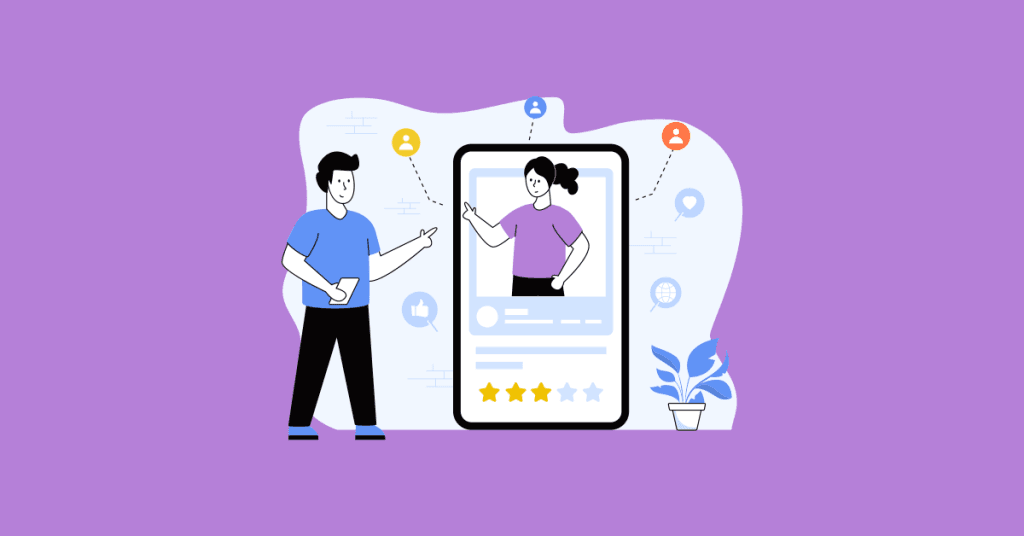Social media listening and social media monitoring are often used interchangeably. While they have similarities, they have different approaches and goals.
Social media listening is a proactive method of gathering insights and feedback by tuning into conversations online. On the other hand, social media monitoring employs a reactive approach by tracking brand mentions and related topics.
That’s one of several ways these two practices differ. Both can positively impact your social media campaigns, but which one is right for you?
This article will guide you toward that decision. First, we will explain what social media listening and social media monitoring really mean. Then, we can finally get to the meat of the article: choosing between one of these strategies.
What is Social Media Listening?
Social media listening, or social listening, is a proactive way of observing social media channels for conversations about your brand, competitor brands, or industry-related topics.
Social listening reveals why, where, and how these subjects are discussed. This information can help you better understand your audience’s preferences, concerns, and sentiments toward your brand.
In addition, it can inform various aspects of business to business marketing strategies, from product development and messaging to content creation, lead generation, and customer engagement.
For example, through social listening, a software company discovers that customers in its industry are discussing the need for more user-friendly interfaces. This then informs their future updates.
What is Social Media Monitoring?
Social media monitoring, or social monitoring, is a subset of social media listening. It is the practice of tracking social media platforms to find out what people are saying about your brand, product, or service. Once you learn about the discussions people are having in relation to your brand — this can be complaints, questions, or appreciation — you can then reply to these messages individually.
For example, through social monitoring, Mailchimp is able to track this post that mentions the brand. Fortunately, it is a positive comment about how the service helped a customer create a stunning newsletter. Then, the social media handler rightly responded with a cheerful GIF. This customer will surely appreciate this interaction.
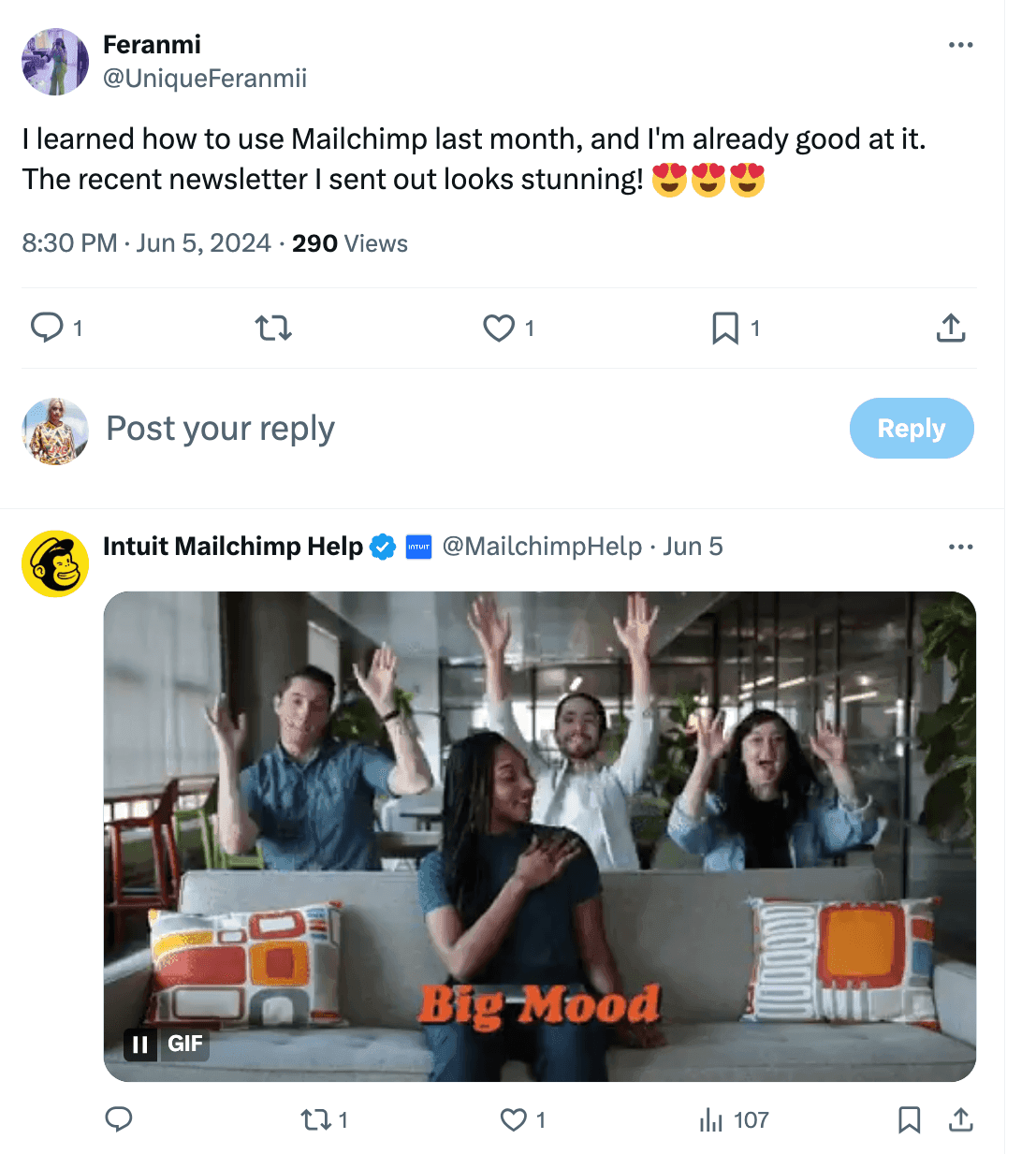
Screenshot from X
Social monitoring is a reactive process that focuses on creating real-time, short-term solutions. Its main aim is to improve customer engagement and brand reputation.
Social Listening vs Social Monitoring: Key Differences
The main difference between social listening and social monitoring is that the former looks at the bigger picture, while the latter focuses on the present. This is evident in each strategy’s execution.
Here are other ways social listening and social monitoring differ.
1. Purpose and Objectives
The primary goal of social monitoring is simple: to track different social media platforms for mention of your brand, product, or service. This means tracking branded keywords, hashtags, and industry-related keywords.
All it takes is to set up your social monitoring software to scrape social channels for any mention of your company name or product. Then, your social media manager or designated team member can manually address these mentions.
For instance, if they discover customers are complaining about your app lagging, they acknowledge this concern and assure clients they’ll forward it to the right team. Once the problem is resolved, clients get an update, and that chapter is closed.
On the flip side, social listening is much more than that. It has diverse objectives, including increasing brand recognition, creating products, and designing marketing campaigns that meet consumer and market demands.
Like the best email tracking software that reveals the entire email journey from open to click, social listening tools such as Keyhole provide a comprehensive overview of online conversations, from tracking trending topics to identifying key influencers and measuring sentiment analysis.
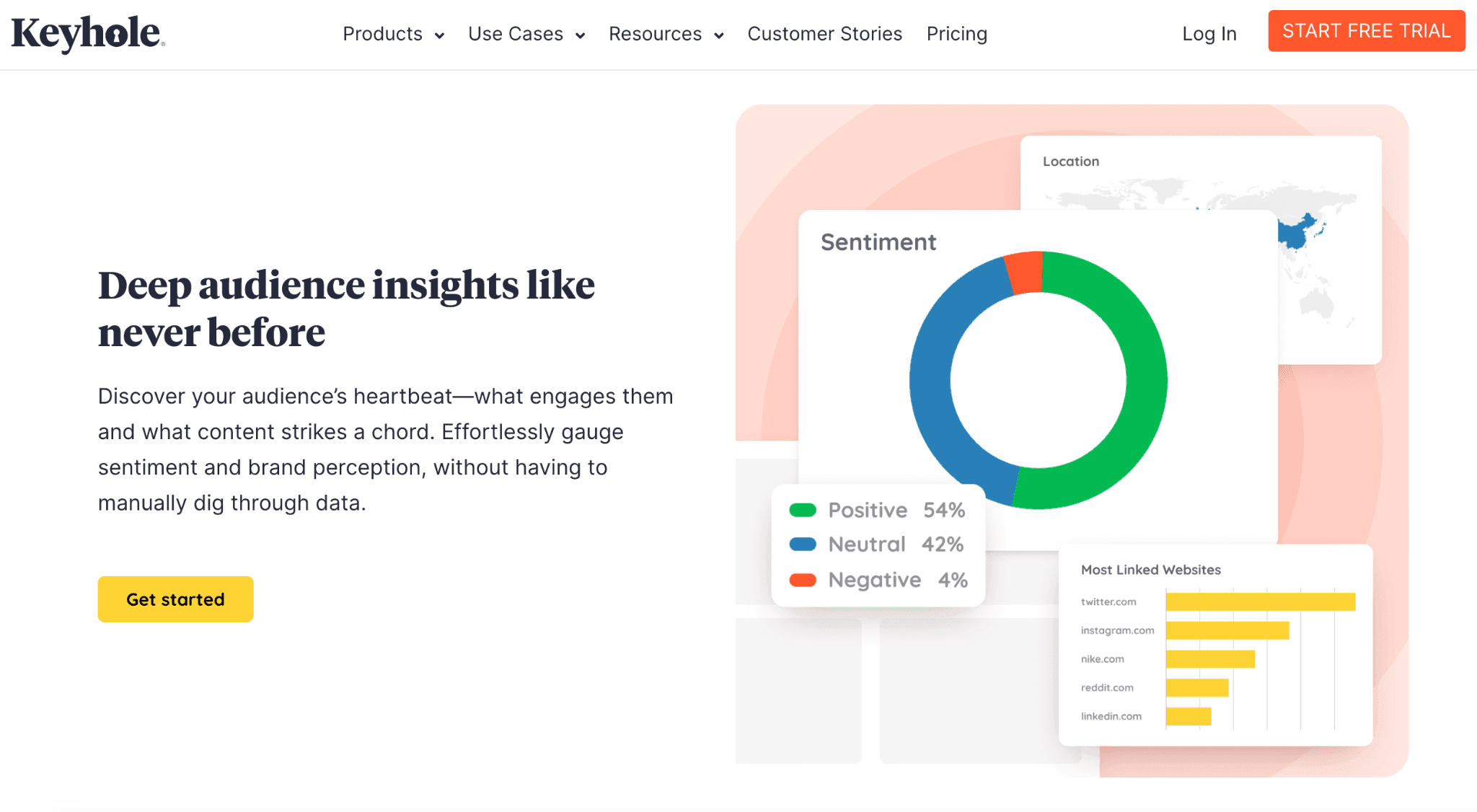
Screenshot from Keyhole
As a result, brands can better understand their audience and tailor their approach to create more impactful campaigns.
2. Scale
Social monitoring happens on a micro level, where sales or customer support reps actively find customer queries, complaints, or comments to respond promptly. This is typically a once-and-done activity.
Of course, if another client joins the conversation, your team will engage and help them. Plus, your customers could still contact you if they have more questions, but generally, it is a short-term interaction.
Social listening, on the other hand, works on a macro level. It examines conversations about your business, products, representatives, competitors, and industry.
Rather than interacting with separate conversations, you work with a large amount of social data. This helps you understand customers’ perceptions of your brand, competitors, social events, and more. Social listening can show your brand’s strengths and shortcomings.
Think of it this way: if social monitoring is checking the pulse of social media activity in real-time, social listening is conducting a thorough health checkup to understand overall well-being and make informed future health decisions.
3. The Urgency
Social monitoring is a reactive process, which means it is time-sensitive. By nature, it doesn’t happen unless an event occurs — for instance when a customer gives a bad review about your service. Such a situation demands urgent attention to prevent it from becoming a bigger problem. Social monitoring is a crisis management instrument.
As you already know, social listening is a proactive process. Nothing needs to happen before social listening starts. It works in the background like a subtle but ever-present guardian. Since it involves constantly observing social conversations around your brand and industry, you can nip any issue in the bud. Social listening is there to ensure there is no crisis to solve in the first place.
4. Automation
Social media monitoring and social listening can be automated. However, the degree of automation differs.
With social monitoring, you can use a tool to sort, categorize, and chronological order all brand mentions. You can also manually track mentions by going through your notifications. Regardless of your approach, you will have to manually respond to queries and comments. It has to be a human-to-human interaction.
Also, finding untagged brand mentions, such as spelling errors or indirect mentions, is manual and time-consuming.
Social listening, however, heavily relies on automation tools. Many of these tools, such as BrandMentions, can do more than just find what people are saying about you on social media. Simply input relevant keywords and phrases into the system, and it will return a detailed report of all online mentions related to your brand or topic.
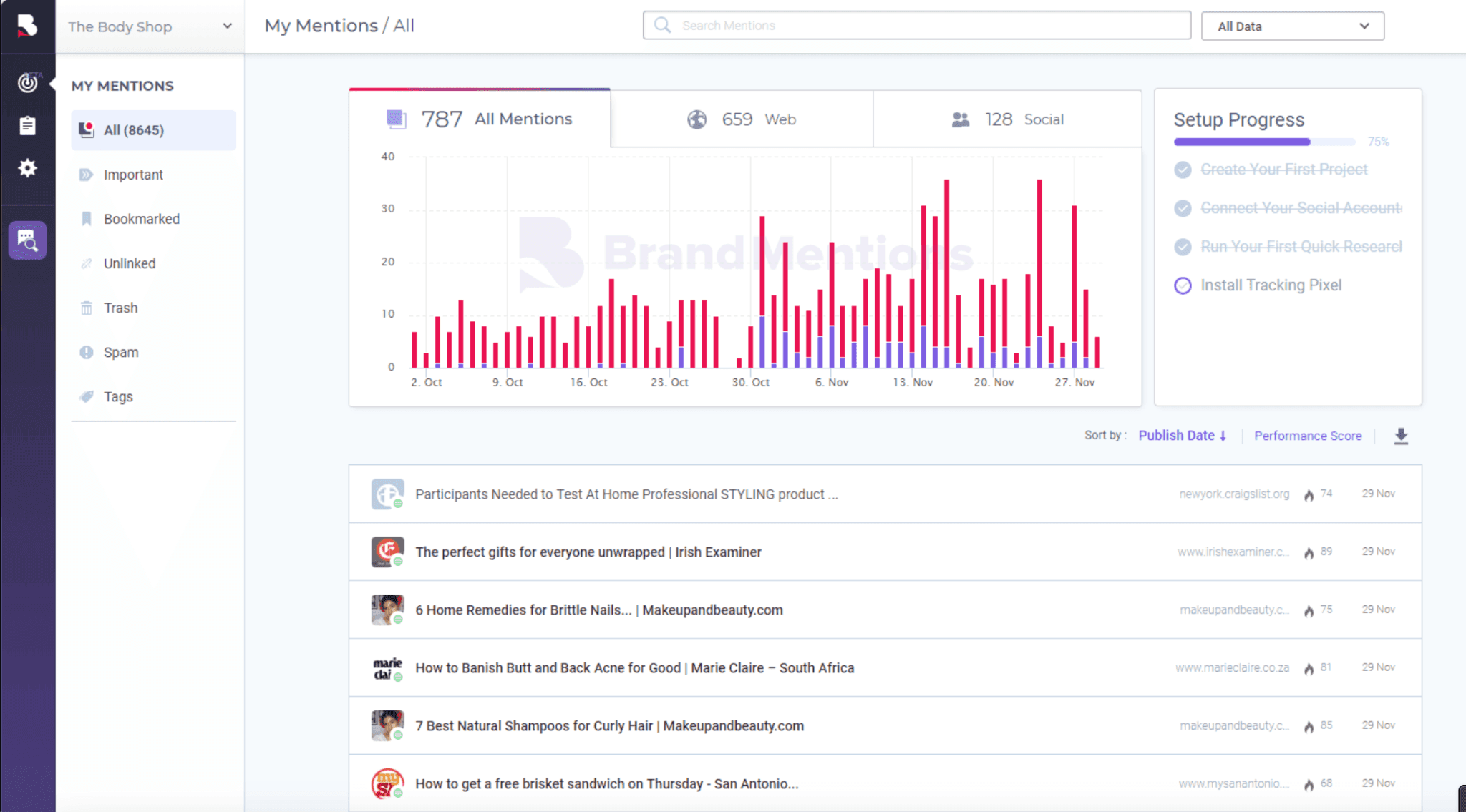
Screenshot from Brandmentions
Automated tools also help you keep track of online mentions of your competitor’s name as well as manage and analyze large amounts of data. This gives you comprehensive insight that is impossible with manual monitoring.
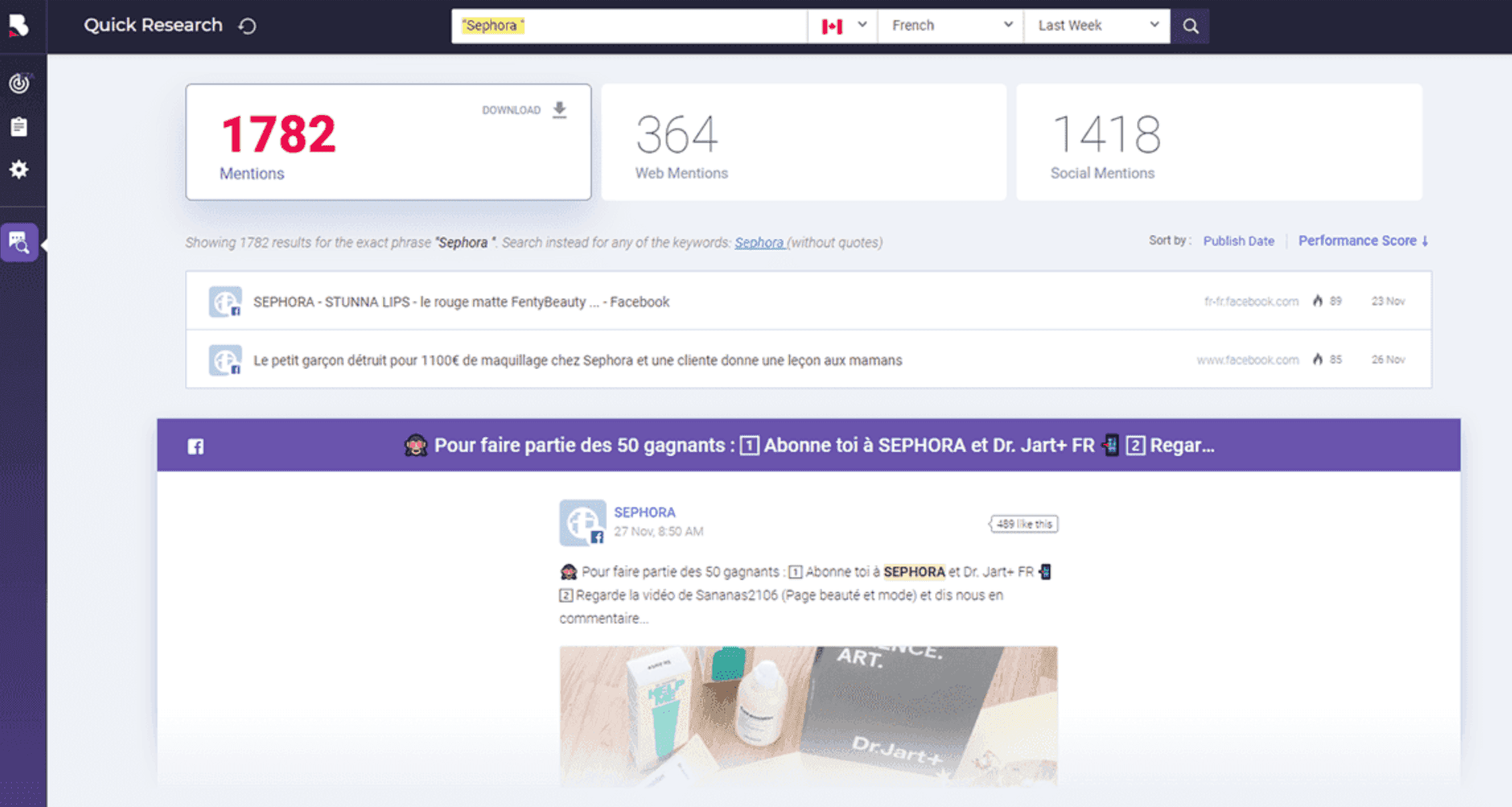
Screenshot from Brandmentions
Now that we know the distinction between these two practices let’s discuss the best time to deploy them.
When to Use Social Listening
Social listening gives you data that enables you to better position your brand and form stronger bonds with your audience. So use this strategy when you want to do the following.
Understand Your Audience
Social media helps you to know your audience better and what they care about. People share a lot on social media. You can learn a lot if you pay attention.
For example, in 2021, this customer shared how she enjoys using her personal channel on Slack to jot down. However, she’d love it if it could function more like a to-do list where she could check things off. She tagged Slack in the post, and they were listening.
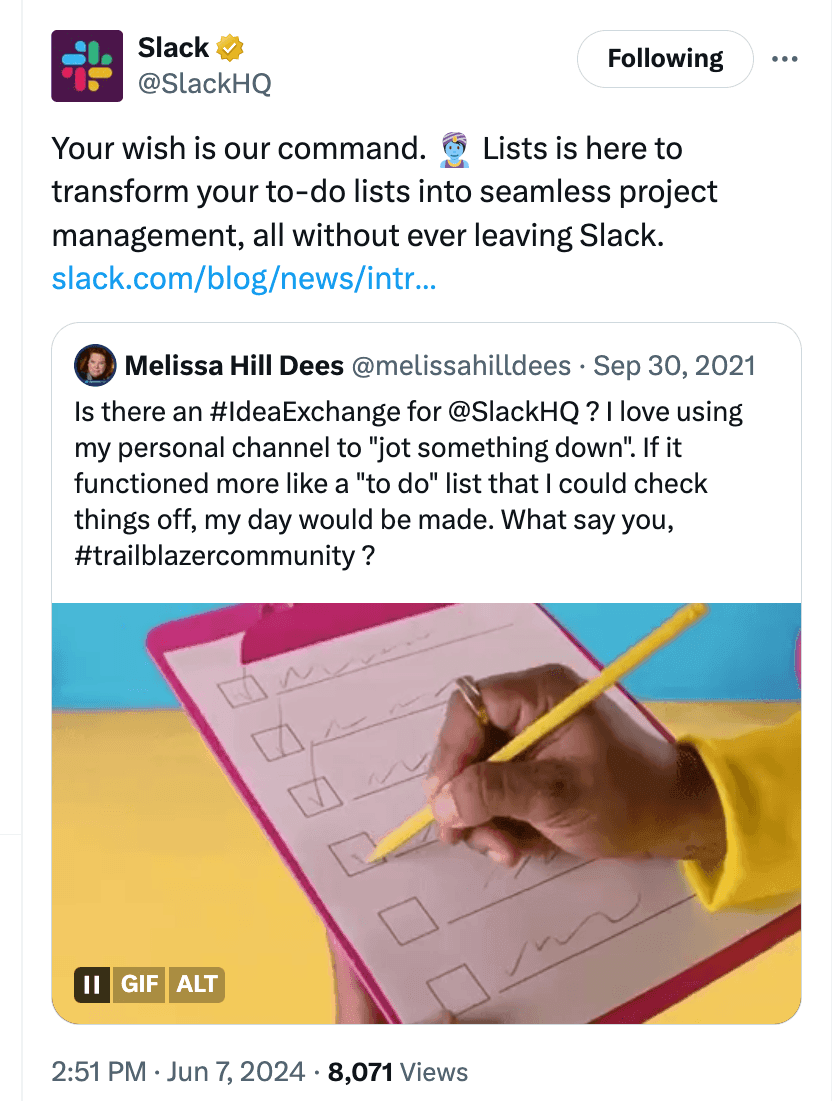
Screenshot from X
Three years later, the business messaging app company granted that wish. They responded to the post by saying that they now have a new feature called Lists that allows users to create to-do- lists directly in their channels.
This is an excellent example of how social listening can help you understand your customers’ needs. However, customers don’t necessarily have to tag your brand for you to notice and take action. You may spot a conversation where people are looking for a solution your product can offer, that’s another way to learn about your customers.
Customer Acquisition
Social listening is an effective way to acquire new customers if you actually listen. It can help you discover conversations about your industry and present opportunities. However, you must not be too pushy or insert yourself into the conversation without adding value.
Let’s say you offer a voice over internet protocol (VoIP) service. Then, through social listening, you stumble upon a conversation in which businesses complain about the high costs of traditional phone services.
This gives you an opportunity to offer a cheap alternative, your VoIP system. However, you need to be subtle in your approach. Don’t insert yourself into the conversation and try to sell right away, read the room.
For example, instead of sounding too obvious and scaring them away, you can say, “One of the advantages of VoIP phones is that they are cheaper than traditional wired telephone service because they use the internet to make calls. This can result in significant savings for a business.” Then, you can ask them to check out your service.
Drip executes this perfectly in this thread. The social media handler followed the conversation and waited for someone to talk about their service before joining in and asking them to check it out. That’s as smooth as you can get.
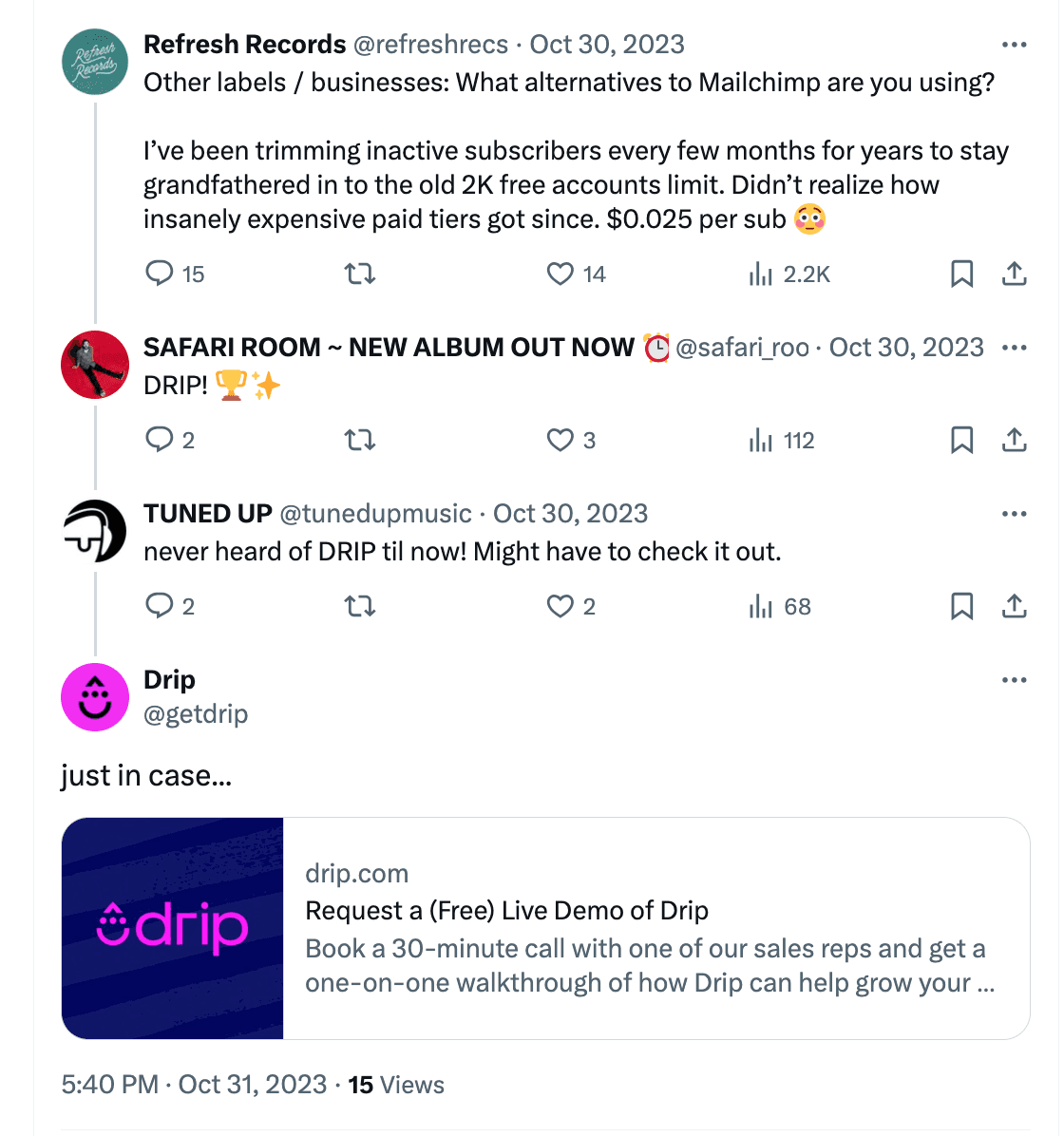
Screenshot from X
Prevent Crisis
Implementing social listening can help you put out fires before they start. It allows you to monitor sentiment as it changes. As a result, you know when people are talking about your brand in a different way. This lets you nip problems in the bud.
If the feeling about your brand is becoming less positive, analyze social feedback to identify the cause and address it. Take the lessons from that situation to prevent future occurrences.
For example, if you notice engagement has reduced with your posts, find out why. A Social listening tool can show you the analysis of how interactions dipped. Then, you can find the cause and resolve it. Perhaps it could be that you changed your brand voice so users no longer resonate with your content. If that’s the case, revert to your original voice and monitor the response.
If engagement starts increasing, you now know not to veer away from your brand voice again.
Leverage Influencer Marketing
Following social conversations about your industry helps you recognize the top creators in your niche. These are opinion leaders who can amplify your brand message. So, connecting with them is essential.
If they are already brand advocates, great. It would be easy to get them on board. But if they aren’t, reach out to them and appreciate their work. Then, offer them an opportunity to collaborate.
This kind of partnership is a win-win because it allows you to tap into their audience, while also providing them with valuable content. Plus, you will be talking about them too, so they get some exposure in return.
Through social listening, Figma was able to identify one of the top designers in its industry to speak at Config, Figma’s annual conference where designers and development enthusiasts gather to share ideas and collaborate.
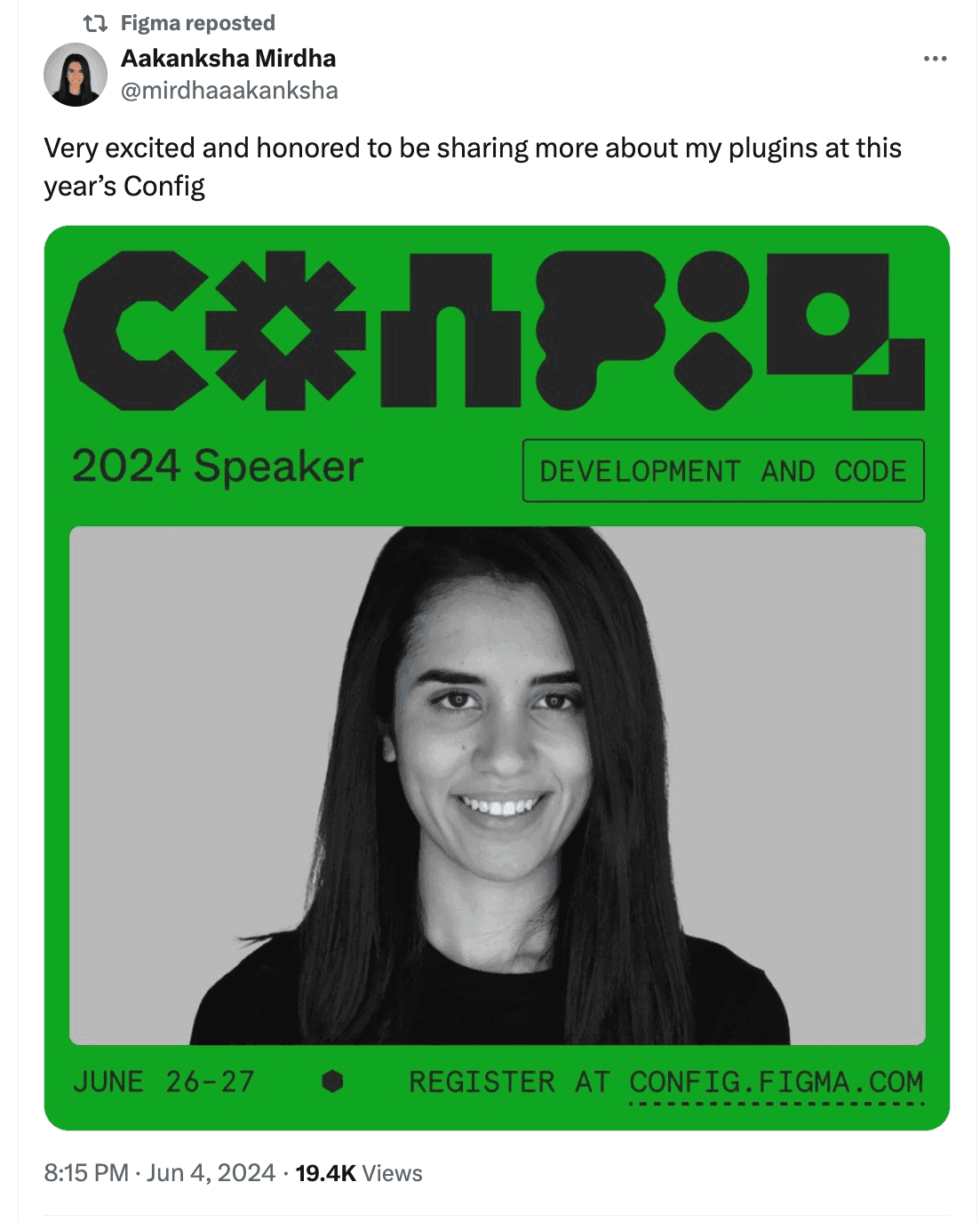
Screenshot from X
Competitor Intelligence
Social listening goes beyond learning what people are saying about you. It also involves gathering intelligence on your competitors. What is your competitor doing? What are their customers saying? How are they perceived in the industry?
The answers to these questions might reveal a market gap you can fill. If your competitor’s customers are complaining about poor customer support, empower your team to provide exceptional support and win over dissatisfied customers.
When to Use Social Monitoring
Social monitoring is basically your brand’s customer support over social media. It is also how you talk to your customers online. Use this strategy for the following.
Improve Customer Service
Social media is the primary channel through which most brand-customer interactions occur. So, if customers have questions, feedback, complaints, or other concerns, they will turn to this channel.
With good social monitoring practices, you can discover social mentions and address them in real-time. This shows customers that you value their opinions and are committed to providing excellent service.
Dropbox has an effective social media monitoring strategy, so it set up a separate account to handle customer support issues. Even though the customer doesn’t tag them, Dropbox can still track mentions through keywords and respond promptly.
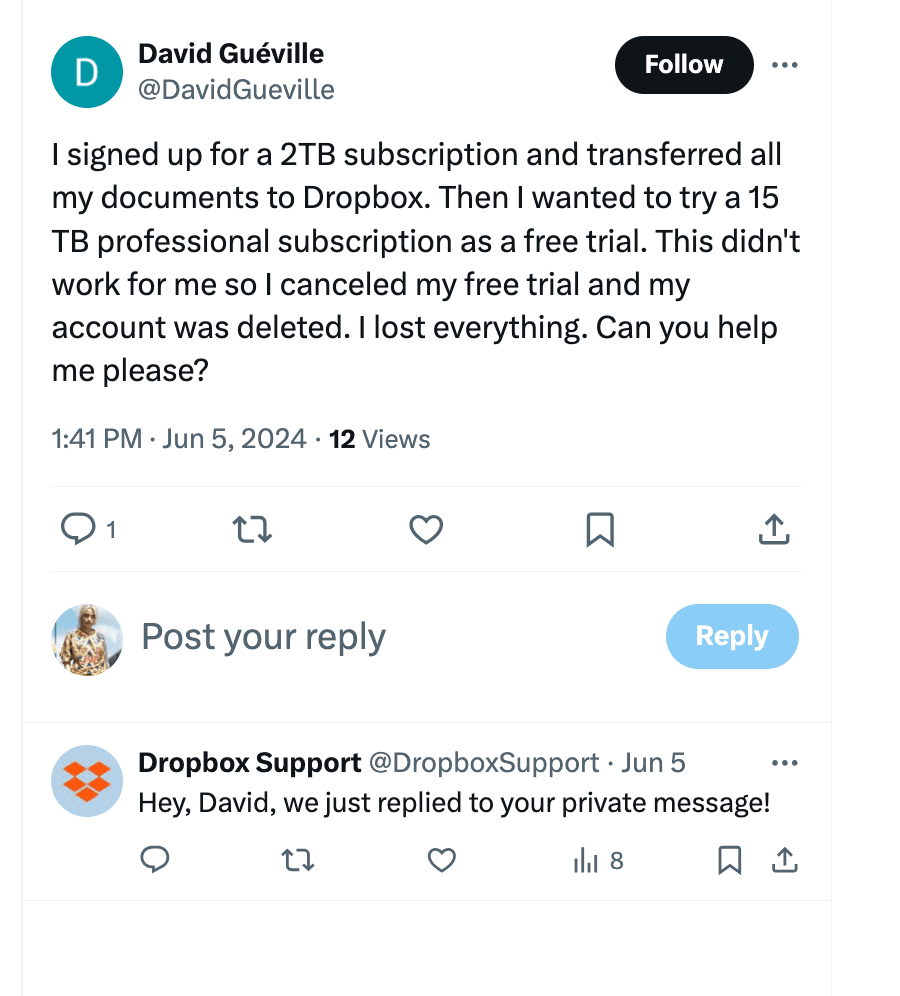
Screenshot from X
Connect with Your Community
Checking social media for what people are saying about you and industry-related keywords can give you a way into the community. As you monitor these channels, you get a sense of what your audience likes. This can be the words they use or the content they enjoy. For example, they may like memes and more laid-back content.
Adopting this approach can help you engage better with them and build stronger relationships. Through social monitoring, Figma knows its audience relates to memes, so it joins the Hey What’s Ur Job and Hey What’s Ur Interest meme trend.
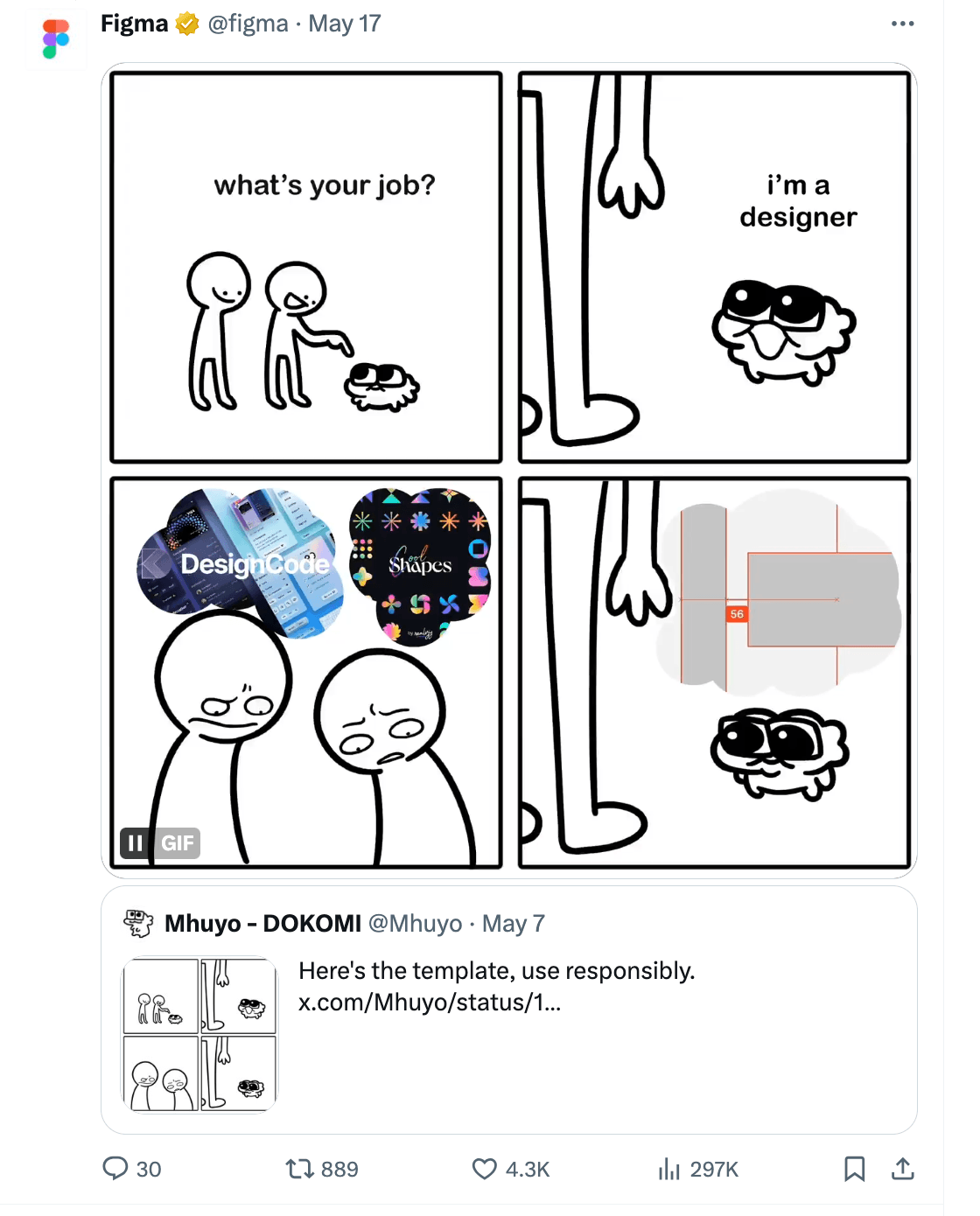
Screenshot from X
Looking at the engagement the post got, it was a hit with their followers.
Crisis Management
Monitoring social media helps you identify customer grievances that could escalate into a crisis. If a social media post puts your brand at risk, you can quickly address it and save your brand’s reputation.
This interaction between Dropbox’s support page and a clearly irate customer is a prime example of how social monitoring can help manage a crisis. The post already got several comments, so if Dropbox doesn’t intervene, it can become even more chaotic.
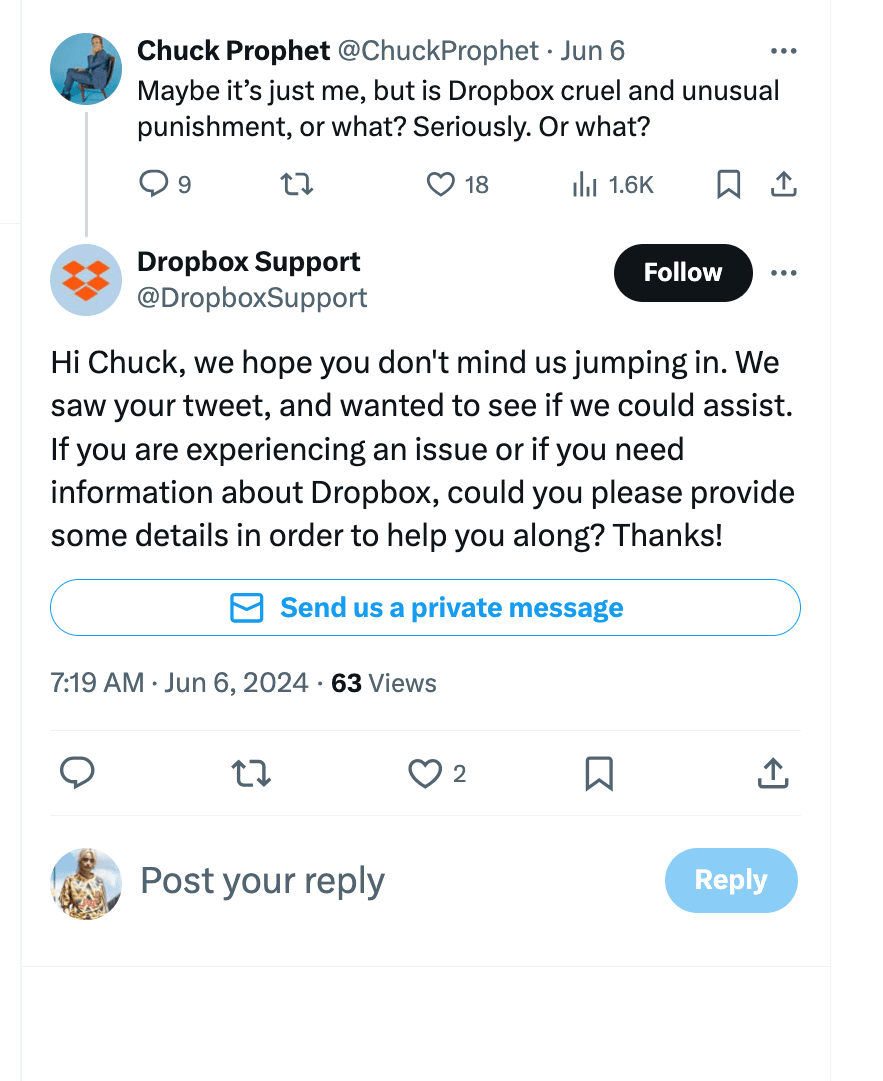
Screenshot from X
Which Strategy Should You Choose?
Social media listening and social media monitoring are both important strategies for online success. You don’t have to choose one strategy because you can use both.
Social listening focuses on the bigger picture. Implement it to understand the overall trends and sentiments related to your brand or industry. Keep in mind that social listening is ineffective if you don’t act on the insights you gather.
Conversely, social monitoring is about the present. It provides instant solutions to emerging issues or customer queries. Apply this strategy to keep track of your brand’s reputation in real-time.
